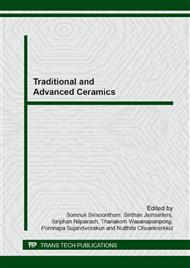[1]
D. van Halem, Ceramic silver impregnated pot filters for household drinking water treatment in developing countries, Master's thesis, Faculty of Civil Engineering, Delft University of Technology, Netherlands, (2006).
DOI: 10.2166/ws.2007.142
Google Scholar
[2]
R.W. Dies, Development of a ceramic water filter for Nepal, Master's thesis, Department of Civil and Environmental Engineering, Massachusetts Institute of Technology, USA, (2003).
Google Scholar
[3]
B. Michen, A.T. Diatta, J. Fritsch, C. Aneziris, T. Graule, Removal of colloidal particles in ceramic depth filters based on diatomaceous earth, Sep. Purif. Technol. 81 (2011) 77-87.
DOI: 10.1016/j.seppur.2011.07.006
Google Scholar
[4]
J.J. Simonis, A.K. Basson, Evaluation of a low-cost ceramic micro-porous filter for elimination of common disease microorganisms, Phys. Chem. Liq. Earth. 36 (2011) 1129-1134.
DOI: 10.1016/j.pce.2011.07.064
Google Scholar
[5]
M. Chaudhuri, S.R. Verma, A. Gupta, Performance evaluation of ceramic filter candles, J. Environ. Eng. 120 (1994) 1646-1651.
DOI: 10.1061/(asce)0733-9372(1994)120:6(1646)
Google Scholar
[6]
Y.F. Liu, X.Q. Liu, H. Wei, G. -Y. Meng, Porous mullite ceramics from national clay produced by gel casting, Ceram. Int. 27 (2001) 1-7.
DOI: 10.1016/s0272-8842(00)00034-1
Google Scholar
[7]
J.H. She, T. Ohji, Fabrication and characterization of highly porous mullite ceramics, Mater. Chem. Phys. 80 (2003) 610-614.
DOI: 10.1016/s0254-0584(03)00080-4
Google Scholar
[8]
X. Zhipeng, Study on binder removal process of ceramics injection molding, Bull. Chin. Ceram. Soc. 2 (1998) 18-21.
Google Scholar
[9]
K. Maca, P. Dobsak, A.R. Boccaccini, Fabrication of graded porous ceramics using alumina-carbon powder mixtures, Ceram. Int. 27 (2001) 577-584.
DOI: 10.1016/s0272-8842(01)00004-9
Google Scholar
[10]
Y. Sakka, F. Tang, H. Fudouzi, T. Uchikoshi, Fabrication of porous ceramics with controlledpore size by colloidal processing, Sci. Technol. Adv. Mater. 6 (2005) 915-920.
DOI: 10.1016/j.stam.2005.07.006
Google Scholar
[11]
W.T. Tsai , K.J. Hsien, Y.M. Chang, C.C. Lo., Removal of herbicide paraquat from an aqueous solution by adsorption onto spent and treated diatomaceous earth, Bioresour. Technol. 96 (2005) 657-663.
DOI: 10.1016/j.biortech.2004.06.023
Google Scholar
[12]
P.F. Schuler, M.M. Ghosh, P. Gopalan, Slow sand and diatomaceous earth filtration of cysts and other particulates, Water Res. 25 (1991) 995-1005.
DOI: 10.1016/0043-1354(91)90149-k
Google Scholar
[13]
S. Martinovic, M. Vlahovic, T. Boljanac, L. Pavlovic, Preparation of filter aids based on diatomites, Int. J. Miner. Process. 80 (2006) 255-260.
DOI: 10.1016/j.minpro.2006.05.006
Google Scholar
[14]
J.K. Mwabi, B.B. Mamba, M.N.B. Momba, Removal of Escherichia coli and Faecal Coliforms from Surface Water and Groundwater by Household Water Treatment Devices/Systems: A Sustainable Solution for Improving Water Quality in Rural Communities of the Southern African Development Community Region, Int. J. Environ. Res. 9 (2012).
DOI: 10.3390/ijerph9010139
Google Scholar
[15]
F. Akhtar, Y. Rehman, L. Bergström, A study of the sintering of diatomaceous earth to produce porous ceramic monoliths with bimodal porosity and high strength, Powder Technol. 201(2010) 253-257.
DOI: 10.1016/j.powtec.2010.04.004
Google Scholar
[16]
N. Ediz, İ. Bentli, İ. Tatar, Improvement in filtration characteristics of diatomite by calcinations, Int. J. Miner. Process. 94 (2010) 129-134.
DOI: 10.1016/j.minpro.2010.02.004
Google Scholar
[17]
S. Li, N. Li, Effects of composition and temperature on porosity and pore size distribution of porous ceramics prepared from Al(OH)3 and kaolinite gangue, Ceram. Int. 33 (2007) 551-556.
DOI: 10.1016/j.ceramint.2005.11.004
Google Scholar
[18]
E. Gregorva, W. Pabst, Z. Zivcova, I. Sedlaova, S. Holkova, Porous alumina ceramics prepared with wheat flour, Journal of the European ceramic Society. 30 (2010) 2871-2820.
DOI: 10.1016/j.jeurceramsoc.2010.03.020
Google Scholar
[19]
X.H. Wang, J.Y.H. Fuh, Y.S. Wang, Y.X. Tang, Laser sintering of silica sand-mechanisms and application to sand casting mold, Int. J. Adv. Manuf. Technol. 21 (2003) 1015-1020.
DOI: 10.1007/s00170-002-1424-x
Google Scholar
[20]
A.R. Bielefeldt, K. Kowalski, C. Schilling, S.S.A. Kohler, R.S. Summers, Removal of virus to protozoan sized particles in point-of-use ceramic water filters, Water Res. 44 (2010) 1482-1488.
DOI: 10.1016/j.watres.2009.10.043
Google Scholar
[21]
D. Lantagne, M. Klarman, A. Mayer, K.Y. Preston, J. Napotnikc, K. Jellisonc, Effect of production variables on microbiological removal in locally-produced ceramic filters for household water treatment, Int. J. Environ. Health Res. 20 (2010).
DOI: 10.1080/09603120903440665
Google Scholar
[22]
U. Sjögren, D. Figdor, L. Spångberg, G. Sundqvist, The antimicrobial effect of calcium hydroxide as a short-term intra canal dressing, Int. Endodontic J. 24 (1991) 119-125.
DOI: 10.1111/j.1365-2591.1991.tb00117.x
Google Scholar
[23]
J.S. Cheng, H.G. Qiu, L.Y. Tang, Effect of CaO on sintering and crystallization of CaO-Al2O3-SiO2 system phosphorus slag glass-ceramic, Adv. Mater. Res. 66 (2009) 37-40.
DOI: 10.4028/www.scientific.net/amr.66.37
Google Scholar
[24]
J.F. Siqueira Jr, H.P. Lopes, Mechanisms of antimicrobial activity of calcium hydroxide: a critical review, Int. Endodontic J. 32 (1999) 361-369.
DOI: 10.1046/j.1365-2591.1999.00275.x
Google Scholar


